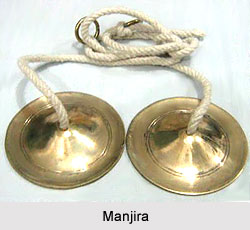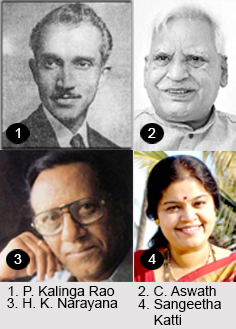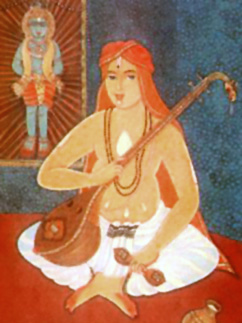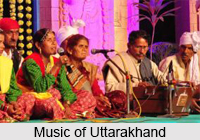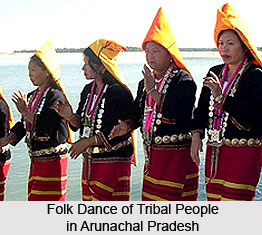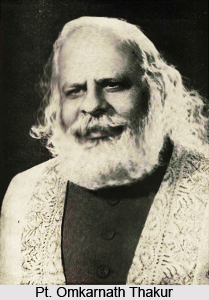 Pandit Omkarnath Thakur was an influential Indian educator, musicologist, and Hindustani classical singer who is also known as "Pranav Rang". A disciple of classical singer Vishnu Digambar Paluskar of Gwalior gharana, he became the principal of Gandharva Mahavidyalaya, Lahore, and later went on become the first dean of the music faculty at Banaras Hindu University.
Pandit Omkarnath Thakur was an influential Indian educator, musicologist, and Hindustani classical singer who is also known as "Pranav Rang". A disciple of classical singer Vishnu Digambar Paluskar of Gwalior gharana, he became the principal of Gandharva Mahavidyalaya, Lahore, and later went on become the first dean of the music faculty at Banaras Hindu University.
For almost three decades, starting from 1930, his was a towering presence in Hindustani Music. He rose to national eminence sharing the stage with formidable rivals like Ustad Faiyyaz Khan and Kesarbai Kerkar, and held on to his position even as the next generation of vocalists like Ustad Bade Gulam Ali Khan and Ustad Amir Khan were acquiring large followings and building awesome reputations.
Pandit Omkarnath was honoured by the President of India with a Padma Shri, and with several decorations by prestigious cultural organizations. He was amongst the few musicians in whose memory the Government also issued a postage stamp. He received honorary Doctorates from Banaras Hindu University and Visva Bharati University. Among his many awards was the title of "Sangeet Martand", which was most commonly used by the music community as a prefix to his name.
Though trained under Vishnu Digambar, a scholar-musician of the Gwalior gharana, Omkarnath deviated substantially from the tradition, and became a daring innovator. In an era when Khayal was still bound by the Dhrupad legacy of formal aloofness, Omkarnath had the courage to adopt an emotionally charged, and even melodramatic, style of rendition. He freely introduced elements of Tappa and Thumri into Khayal rendition, sometimes blurring the borders between the genres. In a milieu in which grammarians were taking over the organization of musical knowledge, he emphasized the esoteric aspects, and even experimented with the healing powers of raga-s.
Omkarnath is often considered a forerunner of the romanticist movement that surfaced in khayal vocalism in the 1970s with the emergence of Kumar Gandharva (1924-1992), Kishori Amonkar (Born: 1931), and Jasraj (Born: 1930). As an artistic ideology, romanticism signifies a preference for emotionally charged expression, along with relative indifference to the structural aspects of music. Omkarnath exhibited a generous dose of classicism in his musical personality. But, with his emphasis on the explicit communication of emotional values through the khayal, he paved the way for later romanticists.
Early Life of Pandit Omkarnath Thakur
Pandit Omkarnath was born at Jahaaj in the Khambhat district of Gujarat. His grandfather and father were both soldiers in the employ of the Peshwa rulers. Under the influence of a saint, Omkarnath`s father, Gaurishankar, lost all interest in worldly affairs. Heedless of the material needs of his family, he became a hermit and devoted his life to Pranava Sadhana -- the exploration of the mysteries of "Om", the primeval sound. This spiritual pursuit led him to name his last child Omkar.
Omkarnath`s mother was cheated out of her husband`s share of the family`s assets, and left destitute, along with her four children. A strong-willed woman, she moved the family to neighbouring Bharuch (Central Gujarat), did menial tasks as a domestic servant, and brought up the children. From the age of five or six, Omkarnath started contributing to the family`s resources by working as a domestic servant, as a cook`s assistant, as a labourer in a textile mill, and as an occasional singer-actor in local theatrical productions. When Omkarnath was in his teens, he came in contact with Seth Shahpurji Doongaji, a philanthropist of Bharuch. The wealthy merchant noticed his talent and passion for music, and sponsored him for training under Pandit Vishnu Digambar Paluskar at the Gandharva Mahavidyalaya in Bombay.
From 1910 to 1916 (according to some accounts: 1913-1919), Omkarnath learnt the vocal art of the Gwalior gharana and the Pakhavaj (two-faced barrel drum), studied authoritative musicological texts, and served his Guru with devotion. When his Guru decided to open a branch of his music school at Lahore, Omkarnath - still in his early 20s -- was sent there as its Principal. Working tirelessly as a teacher and administrator at the Lahore school, he also launched his career as a performing musician. After three years at Lahore, he returned to Bharuch to start a music school, and to launch himself in political activity. His music school was later shifted to Bombay in 1934 and thence to Surat in 1942. His family circumstances had not permitted him to go to school in childhood. But, in his early years, while he was struggling to help support the family, he had worked for a Jain religious establishment, where the monks taught him to read and write. Later on, by his own efforts, he mastered several languages - Hindi, English, Marathi, Sanskrit, Bengali, Punjabi, Urdu and Nepali. With himself as his only tutor, Omkarnath grew to be the most articulate orator and the most profound theoretician amongst musicians of the 20th century.
Career of Pandit Omkarnath Thakur
In 1918, his career took off with impressive concerts at the court of Maharaja Sayajirao Gaekwad III of Baroda, and at the Harballabh Sangeet Sammelan at Jallandhar. A few years later, he visited Nepal at won the admiration of the King, who could not persuade Omkarnath to accept his patronage. By 1930, Omkarnath`s fame had spread far and wide, and he became a star attraction at every major music festival in India.
In 1931, he was invited to the International Music Conference at Florence in Italy. From there, he travelled to Germany, Holland, France, England, Wales, and Switzerland, giving performances and lecture demonstrations, introducing the beauties of Hindustani Music to European audiences. This was an era in which the West knew India only as the land of Gandhi, Tagore, and Pandit Uday Shankar. Indian classical music was an unknown entity. It was Omkarnath who ignited a degree of serious interest in Hindustani music amongst Western scholars and audiences three decades before they had heard the Elder Dagar Brothers, Pandit Ravi Shankar and Ustad Ali Akbar Khan.
During his tenure at BHU, he accelerated work on two major musicological treatises: Pranava Bharati, published in 1956, is landmark treatise on the theoretical aspects of music - swara, raga, and rasa. Sangeetanjali (in six volumes) published between 1938 and 1962, is a manual on the practical aspects of music performance, including raga grammar and aesthetics.
Between 1934 and 1961, Pandit Omkarnath cut over twenty records with HMV in the 78 rpm, 45 rpm and Long Playing formats. On most of these recordings, he was accompanied on the Sarangi by Pandit Ramnarain, the sarangi maestro, who later gave up accompaniment in favour of a career as a soloist. Several of Pandit Omkarnath`s radio broadcasts were posthumously published by All India Radio archives. The repertoire on his recordings consists of Khayals, bhajans, and patriotic songs. As a result, in the popular imagination, Omkarnath is most widely recognized by his two Meera bhajans - Jogi mat jaa, and Pag ghunghroo band Meera naachi re - and his rendering of the national song, Vande Mataram.
While at BHU, Omkarnath suffered a heart attack, recovered from it, and continued to perform. In 1965, he had a paralytic stroke which claimed his life in 1967.
